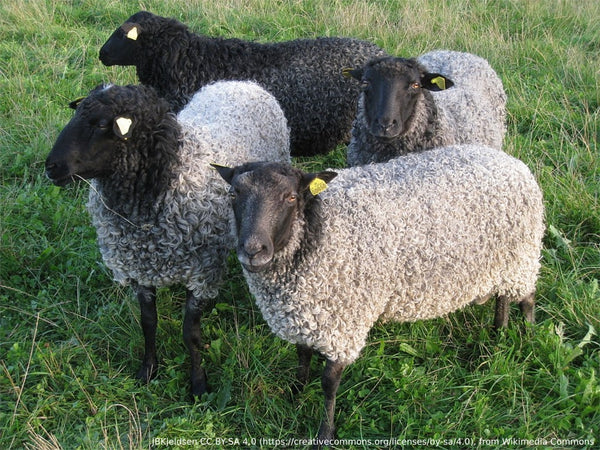Know Your Fiber: Gotland Wool
Posted on November 30 2018

Gotland sheep from the Swedish island of Gotland are not only gosh-darn adorable, but they also produce a beautiful wool with long, lustrous locks. Settle in, Know Your Fiber fans, as we take a little look at this Swedish sheep’s history and touch upon genetic conservation in the sheep raising world.
Gotland sheep are descended from the Gute sheep of Gotland Island, the largest island in the Baltic Sea, which has been occupied by humans for around 6000-8000 years. It is unknown what type of sheep were the very first sheep to arrive on the island – there is evidence of domesticated sheep being kept on the European continent as early as the Neolithic era, and it is not implausible to imagine that sheep made their way to Gotland Island along with Neolithic or Bronze Age settlers. However, what we do know for certain is that as Vikings and other Nordic settlers explored and settled the islands of Northern Europe, they brought their horned, short-tailed sheep with them. It is from these sheep that the Gute, and eventually Gotland sheep, eventually descended.
Over time, Gute sheep became particularly adapted to Gotland Island. The island has sparse grasslands, due to its limestone plains. These limestone plains, known as alvar, have thin soil that cannot support the lush grass that many other sheep would prefer. Faced with this, the already hardy sheep brought by early Gotland settlers began to adapt to eat vegetation such as shrubs and tough plants that other sheep might ignore. Living by the ocean, the sheep also began to adapt to drink seawater when fresh water was unavailable - an unusual trait in any land animal!
Gotland sheep as we know them today began being bred in Sweden during the 1920s. Looking to produce sheep with no horns and a better fleece, Swedish farmers crossed the Gute sheep with Karakul sheep from Central Asia (a hornless breed known for their long curly fleeces) and Romanov sheep from Russia (a hardy, cold weather tolerant breed without horns). This produced sheep with long, silky wool which began to become quite popular when sold as sheepskins. Used for clothing and decor, Gotland sheepskins saw a spike in popularity in other parts of Europe during the 1970s and again in the 1980s when Gotland sheep were imported to the U.K. to develop the flocks needed to meet the rising demand for Gotland sheepskins during those decades.
Although Gotland sheep are still used to produce sheepskins today, an increasing number of Gotland sheep are being raised in order to provide wool for hand spinners, and also for purposes of genetic conservation. Like many primitive sheep breeds, Gotland sheep have unique adaptations to the land they live in, and for Gotland sheep that means being able to drink seawater, and showing a preference for shrubs and tough plants. Not to mention the unique long and lustrous quality of their wool is unlike the wool you might see in the more popular and populous sheep breeds today, such as Merino.
As sheep farms become larger and more industrialized, and as the sheep on these industrialized farms become more and more homogeneous, it becomes ever more important to maintain genetic diversity in other sheep populations. Say, for example, it should become necessary to breed into other sheep the ability to forage off of tougher plants as landscapes change. Other breeds of sheep, such as the Gotland, may be able to contribute these traits to another sheep population. Or perhaps some new disease develops? Well, then, other populations of sheep may show resistance, which could then be bred into affected sheep populations. It could even be something as simple as changing wool preferences – once the rest of the world discovers the silky texture and luster of wools such as Gotland, consumer demand for wool types could change. In short, there are many good reasons to maintain a vast variety of sheep breeds across the world. We never know when we might need that genetic diversity.
Gotland sheep did not start to arrive in North America until 2003, but it is starting to become a popular breed with small-scale farmers on this continent. It is an easy to care for sheep with a wool that is seeing an increased interest among hand-spinners and other fiber artists. Gotland is a long silky wool that when spun and dyed produces a yarn with a wonderful luster reminiscent of mohair and good drape, with a little bit of a halo. Gotland sheep produce wool in a range of grays from light to dark, with the lighter gray wool being most suitable for dyeing. Soft and comfortable to wear against the skin, most Gotland wool is in the 27-33 micron range, with the lighter colors typically having the lower micron count. Want to try some out for yourself? We have Gotland top ready and waiting for you at our shop in downtown Bellingham and on our website. We cannot wait to see what you create!

Follow US